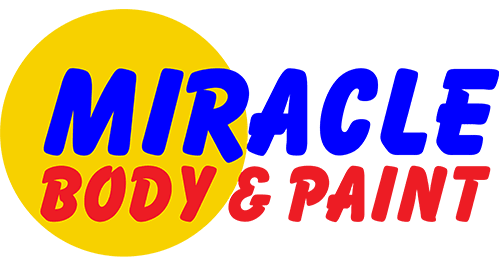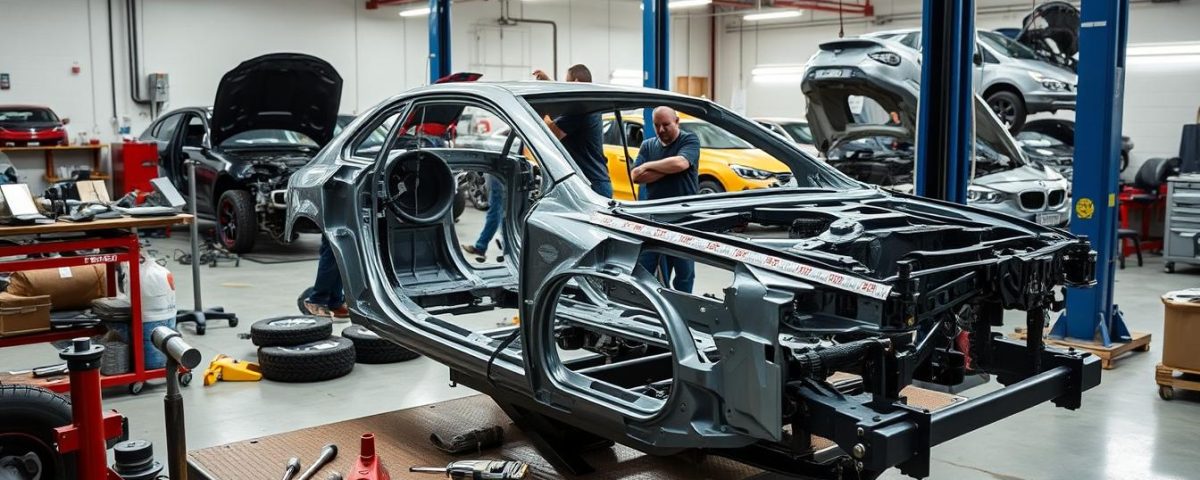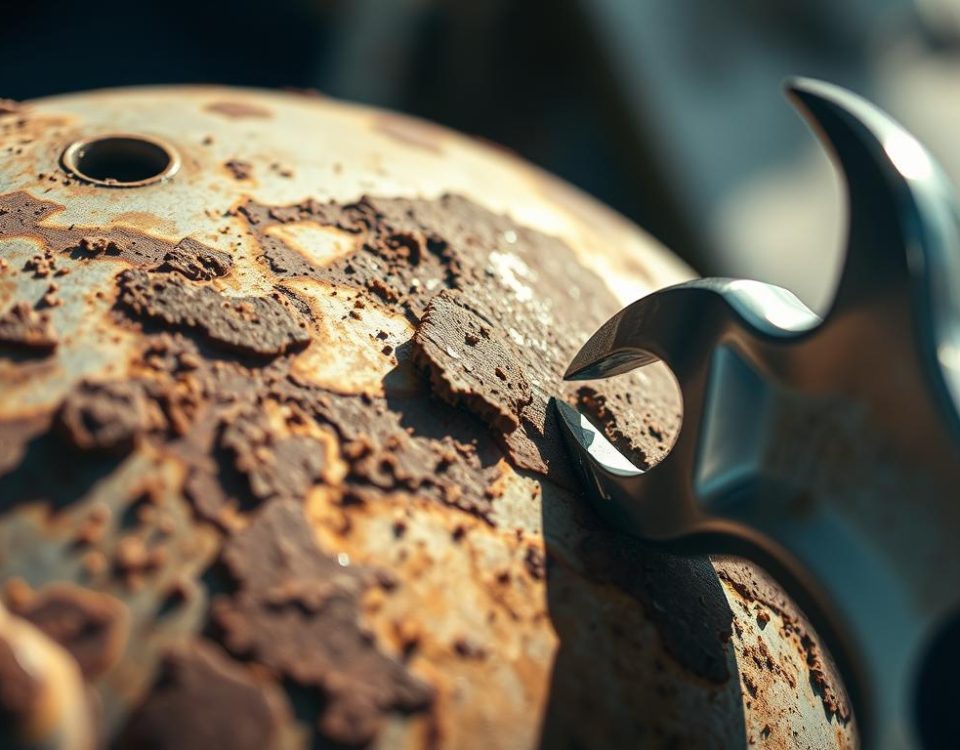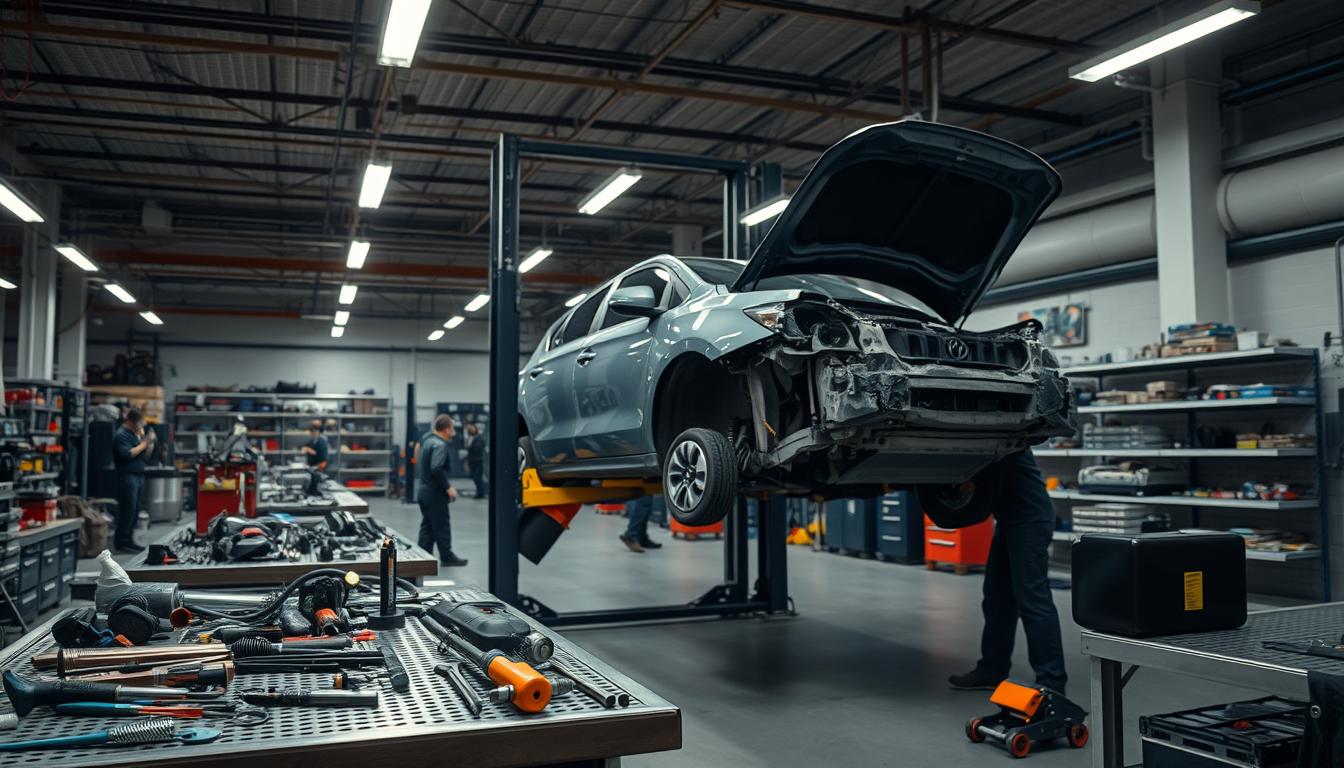
A Beginner’s Guide to Understanding Auto Body Repair
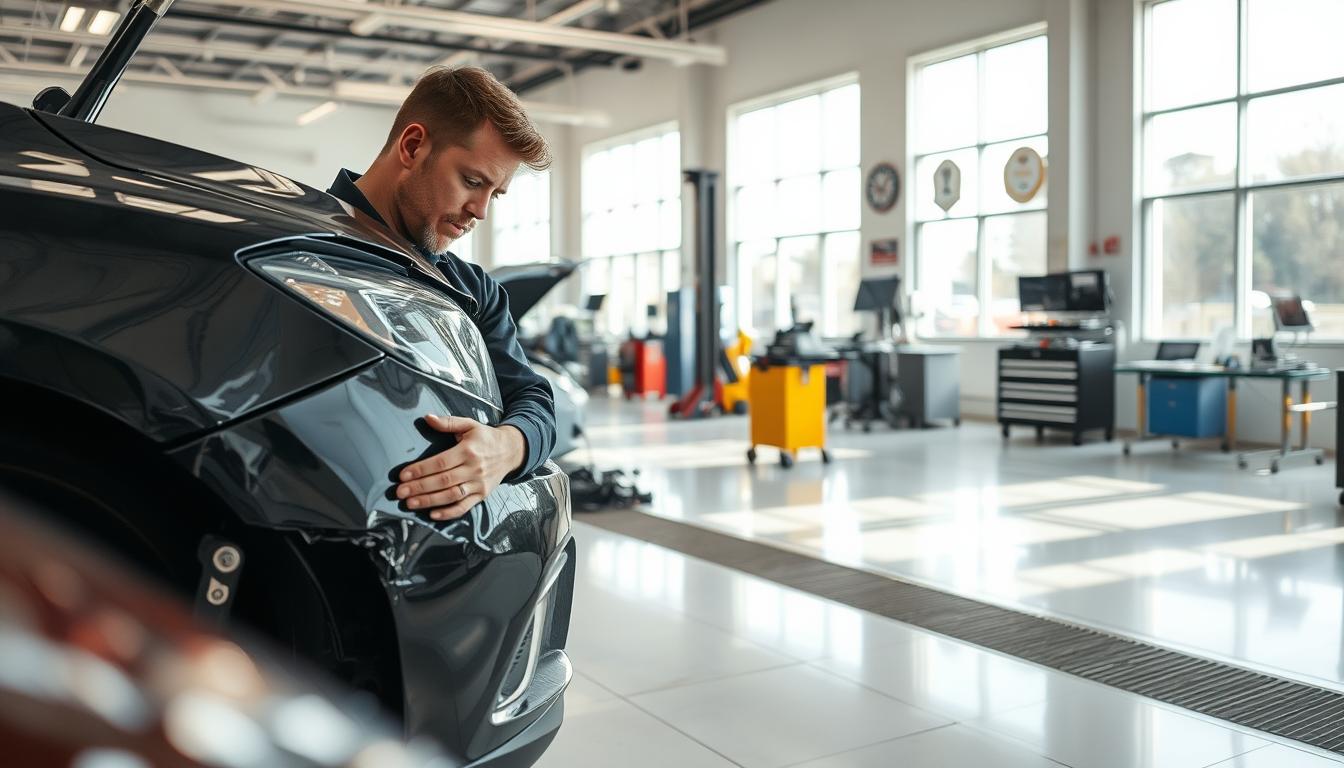
What Services Should a Quality Collision Repair Shop Offer?
After a collision, a vehicle’s structural integrity can be compromised, making frame straightening a crucial repair process. At Miracle Body and Paint, with locations in San Antonio, our experts understand the importance of restoring your vehicle’s original condition.
Frame straightening is a meticulous process that involves realigning the vehicle’s frame to its original specifications. This not only ensures the vehicle’s safety but also its performance and overall value.
In this article, we’ll delve into the process and benefits of frame straightening, providing you with a comprehensive understanding of this critical collision repair service.
Key Takeaways
- Understanding the importance of frame straightening after a collision.
- Learning about the frame straightening process.
- Discovering the benefits of proper collision repair.
- Finding out how Miracle Body and Paint can help.
- Understanding the impact of frame straightening on vehicle safety and performance.
Understanding Frame Damage
When a vehicle is involved in a collision, the impact can cause significant damage to its frame, potentially compromising its safety and performance. The frame is a critical component of a vehicle, and understanding the extent of any damage is essential for determining the necessary repairs.
What is a Vehicle Frame?
A vehicle’s frame is its structural skeleton, providing the foundation upon which all other components are mounted. It is designed to support the vehicle’s weight, absorb and distribute the forces of acceleration, braking, and cornering, and protect occupants in the event of a collision. The frame is typically made of steel and is engineered to be strong, yet flexible enough to absorb impacts.
Common Types of Frame Damage
Frame damage can manifest in various forms, depending on the nature and severity of the impact. Common types include:
- Bending: The frame may bend due to a collision, altering its original shape and potentially affecting the vehicle’s alignment.
- Twisting: A severe impact can cause the frame to twist, leading to misaligned components and potentially compromising the vehicle’s safety.
- Crushing: In severe cases, the frame can be crushed, significantly reducing the vehicle’s structural integrity.
Signs Your Vehicle Needs Frame Straightening
After a collision, it’s crucial to inspect your vehicle for signs of frame damage. Indicators that your vehicle may need frame straightening include:
- Uneven tire wear or misalignment, suggesting that the frame is out of alignment.
- Doors that no longer align properly with their openings.
- Visible signs of damage or rust on the frame.
- A pulling sensation while driving, indicating potential misalignment.
Recognizing these signs early can help prevent further damage and ensure your vehicle remains safe to drive. Frame straightening is a precise process that restores the vehicle’s frame to its original specifications, thereby maintaining vehicle safety and performance.
The Importance of Frame Straightening
The structural integrity of a vehicle is paramount, and frame straightening plays a key role in maintaining it. A vehicle’s frame is its backbone, providing the foundation upon which all other components are built. When a collision occurs, the frame can become damaged, compromising the vehicle’s safety and performance.
Why Frame Integrity Matters
Frame integrity is vital because it directly affects a vehicle’s ability to protect its occupants in the event of another collision. A compromised frame can lead to a failure of critical safety features, putting drivers and passengers at risk.
Key reasons why frame integrity matters include:
- Enhanced safety features functionality
- Better vehicle handling and stability
- Reduced risk of further damage or collapse in future accidents
Impact on Vehicle Safety
The safety implications of a damaged frame are significant. A vehicle with a compromised frame may not perform as expected in critical safety tests, such as crash tests. Moreover, a weakened frame can lead to a loss of control while driving, increasing the risk of accidents.
Some of the safety impacts include:
- Increased risk of injury or fatality in the event of a collision
- Potential failure of safety features like airbags and crumple zones
- Compromised vehicle stability and handling
Insurance Implications of Frame Damage
Frame damage can have significant insurance implications. In many cases, insurance companies will total a vehicle if the cost of repairs, including frame straightening, exceeds a certain percentage of the vehicle’s value.
Insurance implications may include:
- Totaling of the vehicle if repair costs are too high
- Increased premiums due to the vehicle’s compromised history
- Potential disputes over the extent of damage and necessary repairs
The Frame Straightening Process
The frame straightening process is a meticulous procedure that involves several key steps to restore a vehicle’s frame to its original condition. This process is crucial for ensuring the vehicle’s structural integrity and safety on the road.
Initial Assessment and Inspection
The first step in frame straightening is a thorough assessment and inspection of the damage. Technicians use specialized equipment to measure the frame and identify any deviations from its original specifications. This step is critical in determining the extent of the damage and planning the repair.
Using Frame Machines
Once the assessment is complete, technicians utilize frame machines to straighten the damaged areas. These machines are designed to apply controlled forces to the frame, gradually returning it to its original shape. The use of frame machines requires precision and expertise to avoid causing further damage.
Aligning the Frame Correctly
Correctly aligning the frame is perhaps the most critical aspect of the frame straightening process. Technicians must ensure that the frame is not only straightened but also properly aligned with the vehicle’s other structural components. This involves meticulous measurements and adjustments to guarantee that the vehicle operates safely and efficiently.
By following these steps, professionals can restore a vehicle’s frame to a condition that meets or exceeds original manufacturer specifications, ensuring the vehicle’s longevity and the safety of its occupants.
Technology in Frame Straightening
The use of cutting-edge technology in frame straightening has transformed the collision repair industry. With advancements in tools and techniques, professionals can now achieve higher levels of precision and efficiency.
Precision is paramount in frame straightening, as any misalignment can lead to significant safety issues and further damage to the vehicle. Modern technology addresses this concern through various innovations.
The Role of Laser Alignment
Laser alignment technology has become a cornerstone in modern frame straightening. By projecting laser beams onto reference points on the vehicle’s frame, technicians can accurately assess any deviations from the manufacturer’s specifications.
This precise measurement allows for targeted repairs, ensuring that the frame is restored to its original condition. The use of laser alignment minimizes guesswork and enhances the overall quality of the repair.
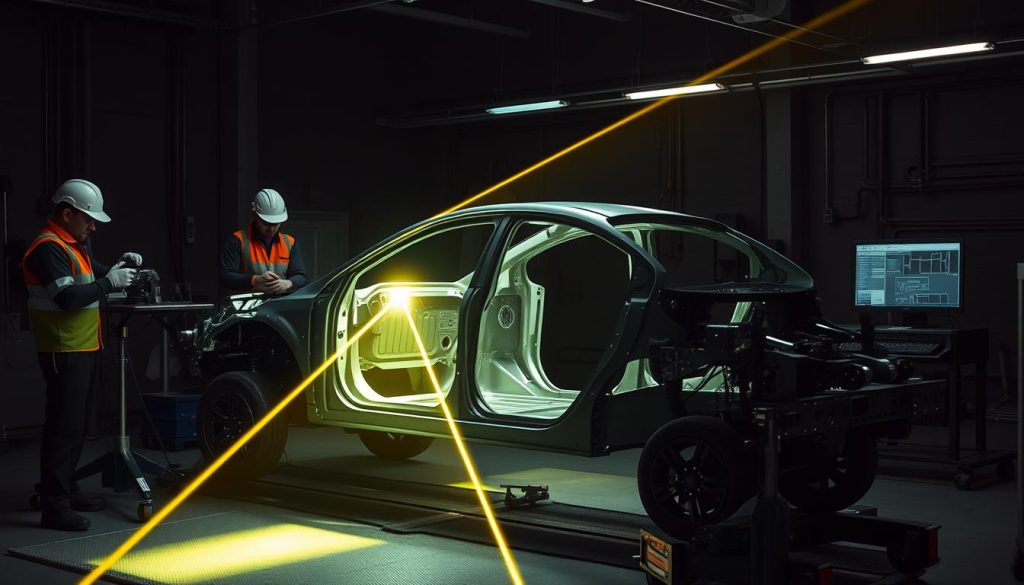
Advanced Tools Used by Professionals
Beyond laser alignment, professionals utilize a range of advanced tools to facilitate frame straightening. These include:
- Frame machines equipped with hydraulic systems to apply precise force
- Computerized measuring systems to track progress and ensure accuracy
- Specialized clamps and fixtures to hold the vehicle in place during repair
These tools work in concert to provide a comprehensive solution for frame straightening, enabling technicians to tackle complex repairs with confidence.
Benefits of Modern Techniques
The integration of modern technology in frame straightening yields several key benefits, including:
- Increased accuracy: Modern techniques ensure that repairs are done to exacting standards.
- Improved efficiency: Advanced tools streamline the repair process, reducing overall timeframes.
- Enhanced safety: By restoring the vehicle’s frame to its original specifications, modern techniques help ensure the safety of occupants.
In conclusion, the technological advancements in frame straightening have significantly elevated the standards of collision repair, offering a more precise, efficient, and safe solution for vehicle owners.
DIY Frame Straightening: Is It Possible?
DIY frame straightening may appear to be a financially savvy decision, but it’s crucial to understand the risks involved. While the idea of saving money on repairs might be tempting, the reality is that frame straightening is a complex process that requires specialized equipment and expertise.
The vehicle’s frame is its backbone, providing structural integrity and safety. When this is compromised due to a collision, professional collision repair is often the only way to ensure the vehicle is restored to its original condition.
Risks of DIY Repairs
Attempting to straighten a vehicle’s frame without proper training and equipment can lead to further damage, compromising the vehicle’s safety and potentially causing injuries or fatalities in the event of another collision.
- Inadequate repairs can lead to misalignment of other vehicle components.
- DIY repairs may not meet safety standards, putting occupants at risk.
- Incorrect frame straightening can result in costly additional repairs down the line.
When to Call a Professional
If your vehicle has suffered frame damage, it’s advisable to seek the services of a professional collision repair shop. These experts have the necessary training, equipment, and experience to restore your vehicle’s frame to its original specifications.
Signs that you need professional help include: visible signs of damage, uneven tire wear, or if the vehicle pulls to one side while driving.
Cost Comparisons
While DIY repairs might seem cost-effective upfront, the long-term costs and risks often outweigh any initial savings. Professional collision repair may seem more expensive initially, but it ensures the work is done correctly and safely, potentially saving money and enhancing safety in the long run.
In conclusion, while DIY frame straightening might be considered, the risks and potential long-term costs make professional collision repair the recommended choice for ensuring vehicle safety and integrity.
How Long Does Frame Straightening Take?
The time it takes to straighten a vehicle’s frame depends on various elements, including the extent of the damage and the technology used in the repair process. Ensuring vehicle safety is paramount, and understanding the timeframe for frame straightening is crucial for planning and maintaining that safety.
Factors Affecting Timeframes
Several factors can influence the duration of frame straightening. These include:
- The severity of the frame damage
- The type of vehicle and its frame design
- The technology and equipment used by the repair shop
- The experience and expertise of the technicians
More complex damage requires more time and potentially more advanced equipment, thereby extending the repair timeframe.
Average Time Estimates
While it’s challenging to provide a one-size-fits-all estimate, most frame straightening jobs can take anywhere from a few days to several weeks. For minor damage, the process might be completed within 3 to 5 days. However, more severe cases can take up to 3 weeks or more.
Managing Expectations
It’s essential to have realistic expectations when it comes to frame straightening. Vehicle owners should:
- Consult with professionals to get a detailed assessment
- Understand that quality repairs take time
- Prioritize vehicle safety over quick fixes
By doing so, they can ensure that their vehicle is restored to its optimal condition, maintaining safety and performance.
Choosing a Frame Straightening Shop
A successful frame straightening process begins with choosing a reliable and skilled repair shop. When your vehicle has been involved in a collision, the importance of selecting the right service center cannot be overstated.
What to Look for in a Service Center
When searching for a frame straightening shop, there are several key factors to consider. Reliability and expertise are paramount. Look for a center that has a proven track record in handling complex frame repairs. The shop should be equipped with modern technology, such as laser alignment tools, to ensure precision.
- Experience with various vehicle types
- Advanced repair equipment
- A clear and comprehensive repair process
Reading Reviews and Recommendations
One of the best ways to gauge the quality of a frame straightening shop is by reading reviews and seeking recommendations. Online reviews can provide insights into the experiences of previous customers, highlighting the shop’s strengths and weaknesses. Additionally, ask friends, family, or your insurance company for recommendations.
- Check online review platforms
- Ask for personal recommendations
- Verify the shop’s reputation with the Better Business Bureau
Certification and Training
Certification and ongoing training are indicators of a shop’s commitment to excellence. Technicians who are certified by recognized industry bodies have demonstrated a level of competence that is crucial for complex repairs like frame straightening. Look for shops that invest in their technicians’ ongoing education and training.
By carefully considering these factors, you can select a frame straightening shop that will restore your vehicle to its pre-collision condition. For top-notch collision repair services, consider Miracle Body and Paint, where expertise and customer satisfaction are paramount.
The Costs of Frame Straightening
Understanding the costs associated with frame straightening is crucial for managing expectations and budgeting after a vehicle collision.
The cost of frame straightening can vary significantly based on several factors, including the extent of the damage, the type of vehicle, and the repair shop’s rates.
Average Price Ranges
The average cost for frame straightening can range from $500 to $3,000 or more, depending on the severity of the damage.
Here are some general estimates:
- Mild damage: $500-$1,500
- Moderate damage: $1,500-$2,500
- Severe damage: $2,500-$3,000 or more
Factors Influencing Cost
Several factors can influence the cost of frame straightening, including:
- Extent of Damage: More extensive damage requires more time and resources, increasing the cost.
- Type of Vehicle: Luxury or larger vehicles often require specialized equipment and more labor, raising the cost.
- Repair Shop Rates: Different shops charge varying rates based on their expertise, location, and reputation.
Understanding Estimates
When obtaining estimates for frame straightening, it’s essential to ensure that the quotes are comprehensive and include all necessary repairs.
Be sure to ask about:
- Inspection fees
- Labor costs
- Parts and materials needed
- Any additional repairs required
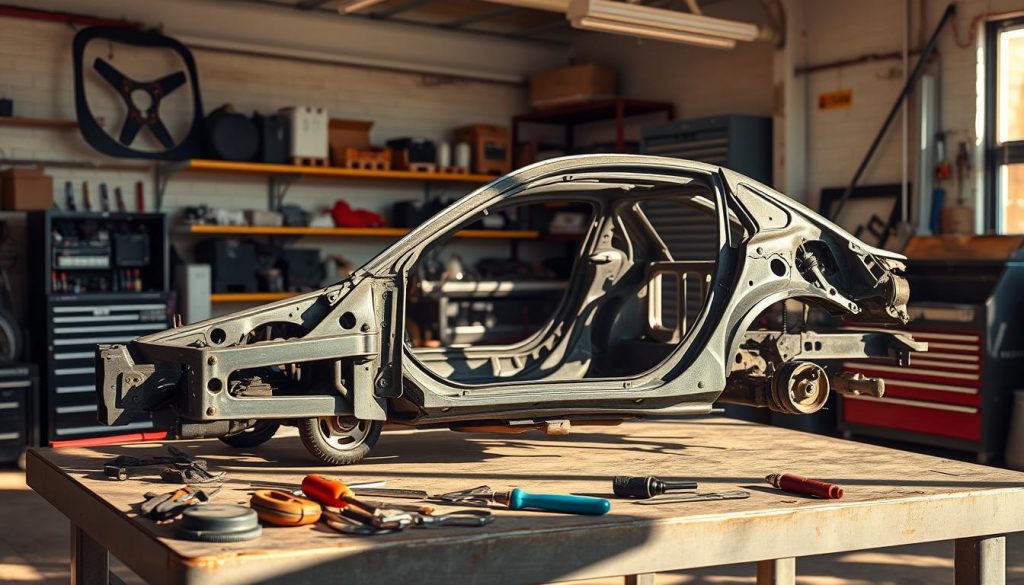
Post-Repair Considerations
Ensuring your vehicle’s frame is properly straightened is just the first step; post-repair considerations are equally important. After investing in frame straightening, vehicle owners should focus on maintaining their vehicle’s integrity to prevent future damage and ensure vehicle safety.
Follow-up Inspections
Regular follow-up inspections are vital to verify that the frame straightening was successful and that no new issues have arisen. These inspections should be conducted by a professional who can assess the vehicle’s frame and other critical components.
During these inspections, technicians will check for any signs of misalignment or damage, ensuring that the vehicle remains in optimal condition. This proactive approach helps in identifying potential problems early, thereby enhancing vehicle safety.
Maintaining Frame Integrity
To maintain the integrity of your vehicle’s frame, it’s essential to avoid situations that could lead to further damage. This includes avoiding extreme temperatures, not overloading the vehicle, and being cautious in hazardous driving conditions.
Regular maintenance, such as checking the vehicle’s alignment and ensuring that all parts are in good condition, also plays a crucial role in maintaining frame integrity. By doing so, you can significantly reduce the risk of future damage and ensure your vehicle remains safe to drive.
Tips for Preventing Future Damage
Preventing future damage requires a combination of good driving habits, regular maintenance, and being mindful of the vehicle’s limitations. For instance, avoiding high-speed driving on rough roads and being cautious when navigating tight spaces can help minimize the risk of frame damage.
Additionally, keeping your vehicle in good condition through regular servicing and addressing any issues promptly can help prevent minor problems from becoming major repairs. By taking these steps, you can help ensure your vehicle’s frame remains in good condition, thereby maintaining vehicle safety and prolonging the vehicle’s lifespan.
Frequently Asked Questions
The process of frame straightening can be daunting, leading to several common questions from those who have experienced a collision. Understanding the intricacies of frame straightening is crucial for making informed decisions about your vehicle’s repair.
Can a Car Be Totaled After Frame Damage?
Yes, a car can be considered totaled after frame damage if the cost of repairs exceeds a certain percentage of the vehicle’s value, typically around 75% to 80%, though this threshold can vary by state or insurance company. Frame damage is a serious issue because it affects the structural integrity of the vehicle. Insurance adjusters assess the damage to determine whether the vehicle is repairable or should be declared a total loss.
How Can I Tell if the Repair Was Done Correctly?
To verify if the frame straightening repair was done correctly, look for signs such as proper alignment of doors, hood, and trunk, and ensure there are no unusual noises or vibrations while driving. A thorough inspection by a professional mechanic can also help identify any potential issues. Additionally, checking if the repair shop used advanced technology like laser alignment can provide assurance of a job well done.
What Are the Signs of Poor Frame Repair?
Signs of poor frame repair include misaligned body panels, uneven tire wear, and persistent vibrations or noises while driving. If the vehicle pulls to one side or if there’s noticeable rust or corrosion on the repaired area, it could indicate subpar workmanship. Regular inspections and monitoring your vehicle’s performance post-repair can help identify these issues early on.
Being aware of these potential signs and taking proactive steps can ensure that your vehicle remains safe and reliable after a collision.
Insurance and Frame Straightening
Navigating the complexities of insurance claims after a collision can be daunting, especially when it comes to frame straightening. Understanding the process and what to expect from your insurer is crucial for a smooth repair experience.
Dealing with insurance companies is a significant aspect of the frame straightening process. It involves not just filing claims but also comprehending the intricacies of your coverage. Proper communication with your insurer can make a substantial difference in the outcome of your claim.
Filing a Claim for Frame Repairs
Filing a claim for frame repairs requires careful preparation. Start by documenting the damage thoroughly, including photographs and detailed descriptions. Your insurance company will need this information to process your claim.
Ensure you have all necessary documentation, including your policy details, vehicle registration, and any relevant repair estimates. Submitting a comprehensive claim can help avoid delays and ensure that your vehicle is repaired correctly.
- Gather all relevant documents before filing your claim.
- Provide detailed descriptions of the damage.
- Include photographs of the damage from multiple angles.
What to Expect from Your Insurer
Once you’ve filed your claim, your insurer will assess the damage to determine the extent of the repairs needed. It’s essential to understand that the insurer’s assessment may not always align with your expectations or the repair shop’s recommendations.
Be prepared to discuss your claim and potentially negotiate the outcome. Clear communication is key to ensuring that your vehicle is repaired to a satisfactory standard.
Understanding Coverage Limitations
Every insurance policy has its limitations and exclusions. Understanding these can help you navigate the claims process more effectively. Common limitations include deductibles, coverage caps, and specific exclusions related to vehicle modifications or pre-existing damage.
Reviewing your policy before filing a claim can help you anticipate potential issues and plan accordingly. If you’re unsure about any aspect of your coverage, don’t hesitate to ask your insurer for clarification.
By being informed and proactive, you can ensure a smoother insurance claims process for frame straightening, getting your vehicle back on the road safely and efficiently.
Conclusion: The Value of Proper Frame Repair
Proper frame repair is crucial for maintaining vehicle safety and ensuring the long-term quality of your vehicle. After a collision, the integrity of your vehicle’s frame is compromised, and if not repaired correctly, it can lead to further damage and safety issues down the road.
Long-Term Vehicle Quality
Frame straightening is a complex process that requires specialized equipment and expertise. By investing in proper frame repair, you can prevent future problems and maintain your vehicle’s overall performance. A correctly repaired frame ensures that your vehicle operates as intended, providing a smooth and safe driving experience.
Safety on the Road
A vehicle’s frame plays a critical role in vehicle safety. A damaged frame can increase the risk of injury or accident. By prioritizing frame straightening, you can ensure that your vehicle is safe to drive and protect yourself and others on the road.
Next Steps
If your vehicle has suffered frame damage, it’s essential to seek professional help. Miracle Body and Paint, with two locations in San Antonio, offers expert collision repair services, including frame straightening. Contact them today to schedule a consultation and take the first step towards restoring your vehicle’s safety and quality.

